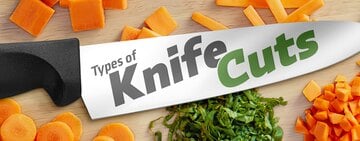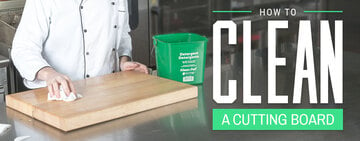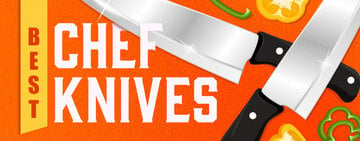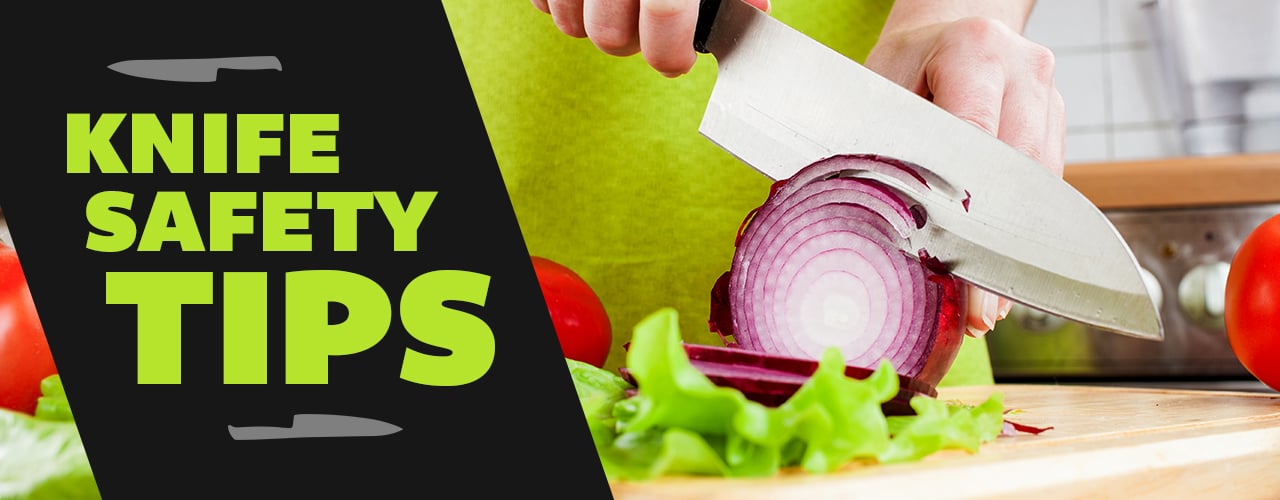
Knife Safety Tips
Last updated on 2/14/2024Knife safety is of utmost importance in any commercial kitchen. Improper handling and usage of knives can lead to serious accidents and injuries. We will explore essential knife safety tips that every professional chef and kitchen staff should be aware of. By following these guidelines, you can enforce restaurant safety protocols in your kitchen while minimizing the risk of accidents.
Kitchen Knife Safety
From "avocado hands" to cuts while washing knives, lacerations from chef knives are one of the most common injuries in foodservice kitchens. Make sure your kitchen staff is educated and avoid potential injury by following our knife safety tips.
1. Use a Sharp Knife

A sharp knife is a safe knife, as the saying goes. When you use a dull knife to cut, you need to apply more force. As a result, the knife is more likely to slip and this increases the risk of injury. Keeping your knives sharpened is one of the easiest ways to keep them safe. Simply use a sharpening stone or knife sharpener to maintain the original precision of the blade. If your knife needs just a touch-up between thorough sharpenings, try using a sharpening steel.
How Sharp Should My Knife Be?
Your knife should be able to handle a knife sharpness test with ease. To balance sharpness and durability, most knife blades are designed with a 20-degree angle on each side of the cutting edge. If you work with many soft ingredients, you may want to sharpen your knife to 15 degrees per side.
A knife with a 15-degree angle requires more frequent sharpening, though, and may decrease the overall durability of your knife. If any of your ingredients are harder in texture, keep your blade at 20 degrees on each side, or choose a wider-angle blade when appropriate.
Knife Sharpening Video
Use the following video to learn how to sharpen a knife with a manual knife sharpener and an electric knife sharpener:
2. Choose the Right Knife for the Task
From cheese knives to Japanese knives, selecting the right knife for the task is one of the most fundamental knife safety tips that foodservice professionals should learn. Making this choice can be overwhelming because of the wide variety of styles, shapes, and sizes of commercial knives.
When choosing the type of knife you need for a task, here are some things you should consider:
- Blade size: Choose a knife that is proportional to the food you’re cutting. For example, a small paring knife will not be very useful for butchering a large cut of meat. You'll want to use a cleaver instead.
- Flexibility: Certain tasks require a flexible blade, while others need a firm one. The knife you’d choose to remove scales from a fish should be sleek and flexible compared to a sturdy knife that you’d need to cut potatoes.
- Blade edge: The edge of the blade can make your job easier or harder depending on the task. For instance, serrated knives are excellent for cutting through foods with tender centers like bread and cake, while granton edge blades are suited for wet foods like cheese and salmon.
Never use your knife for anything but cutting food. Using your knife for other tasks, like opening cans or boxes, could not only put your safety at risk but could also damage your knife.
3. Know the Proper Knife Cutting Techniques
Knowing how to properly cut with your knife is a fundamental part of knife safety. Poor knife handling risks injury and damage to your kitchen tools. Not to mention, incorrectly holding your knife slows you down and decreases the quality of your work.
How to Use a Knife
- Always use a cutting board when cutting ingredients. This will allow you to cut consistently and protect your work surface in the process.
- Take note of your hand positions when cutting. The hand holding the knife should have a secure grip on the handle.
- Use your pointer finger and thumb to grasp the sides of the blade near the handle for added control.
- Keep your other hand out of the way of the blade by clawing your fingertips inward to hold the item steady.
- Bring your blade down and through your ingredients in one smooth motion. This will help you maintain control and produce a neater cut.
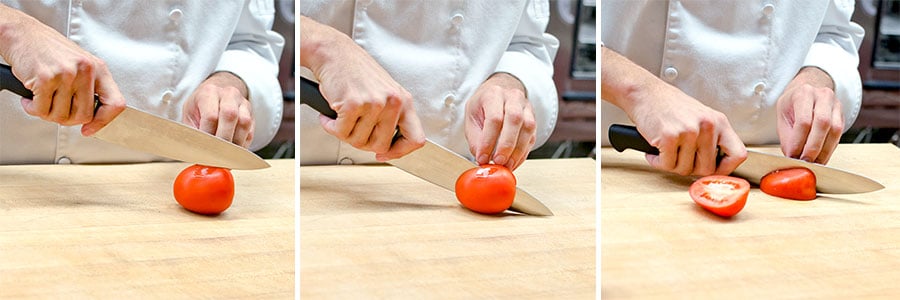
4. Use Caution When Handling a Knife
Though a commercial kitchen can be a hectic place, there are best practices that you and your staff can implement to keep each other safe. The following are some dos and don'ts when it comes to knife handling:
Do:
- Always carry a knife with the blade pointed downward.
- Angle the blade away from your body when you're cutting, washing, or drying a knife.
- Wear a cut-resistant kitchen glove to reduce the chance of injuries.
- Use the kitchen slang "sharp behind" to indicate that you are passing behind someone while carrying a knife to keep them from backing up.
Don't:
- Never use a knife while distracted. Keep your attention on your task or stop what you're doing and deal with the distraction before returning to cutting.
- Do not try to catch a falling knife. It may be an instinct to try to catch the blade, but let it fall before cleaning it or replacing it.
- Never leave a blade out when not in use. Knives left on counters, tables, or soapy sinks are bound to get covered and are an accident waiting to happen.
- Do not chop faster than you are comfortable. It can be tempting to chop rapidly to get food prep done quicker, but if you are chopping at a rapid pace, you are more likely to make a mistake.
- Do not leave knives in the sink to soak. Most knife injuries occur during dishwashing. If a knife is left in the sink, it can get covered by other dishes and soapy water, leaving the dishwasher unaware of the hidden sharp object and at risk of getting cut.
5. Keep Your Knives Clean
To prevent cross-contamination, it is important to clean your knife as soon as you’re done using it. A clean knife is also easier to handle, making cleaner cuts. Food residue can make your knife slippery, so be sure to keep it clean for the most secure grip.

Knife Cleaning Tips
To ensure sanitation and maintain your knife’s durability, be sure that you are washing your knife properly. Here are some things to keep in mind when cleaning your knives:
- Clean knives immediately after use.
- Wash your knives by hand.
- Hold the knife by the handle.
- Scrub slowly and carefully.
- Soak stuck-on food for only a few minutes before scrubbing (never leave a knife in the sink).
- Rinse, dry, and store the knife safely immediately after cleaning.
6. Store Your Knives Correctly
A designated knife storage space keeps your kitchen organized and also encourages a safe knife routine. When not in use, your knives should be stored out of the way of your workspace. Simply putting your knife in a drawer is not safe for your workers or your knife. Use one of the following knife storage solutions:
- Knife Blocks
- Knife Racks
- Knife Sleeves
- Magnetic Knife Holders
- Knife Bags
Back to Top
Understanding and implementing proper knife safety techniques is crucial in any commercial kitchen. By following these tips, such as using the correct knife for each task, maintaining sharp blades, and practicing proper handling and storage, you can significantly reduce the risk of accidents and injuries. Remember to always prioritize safety and provide training to your staff to ensure a safe and efficient work environment.

